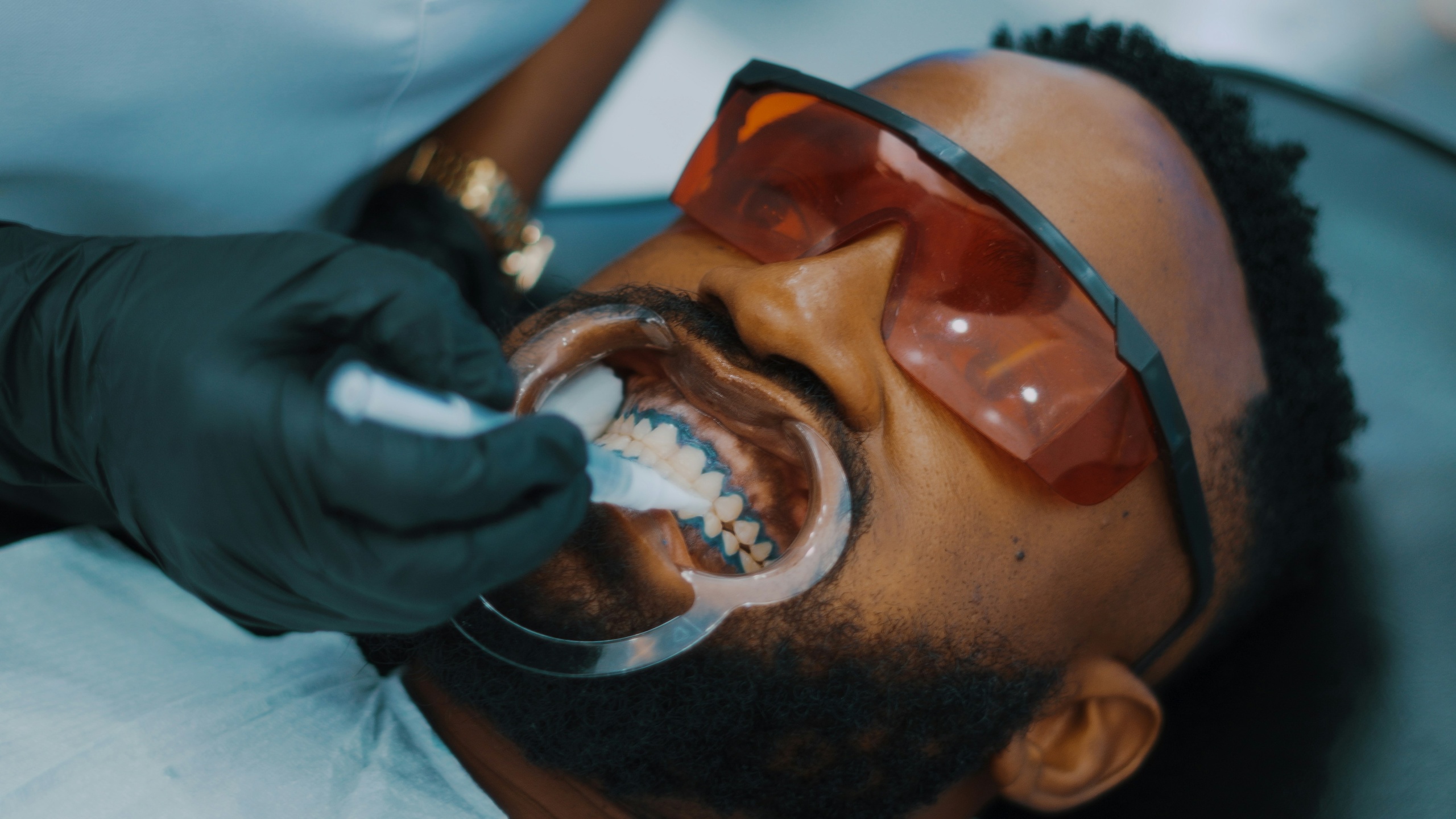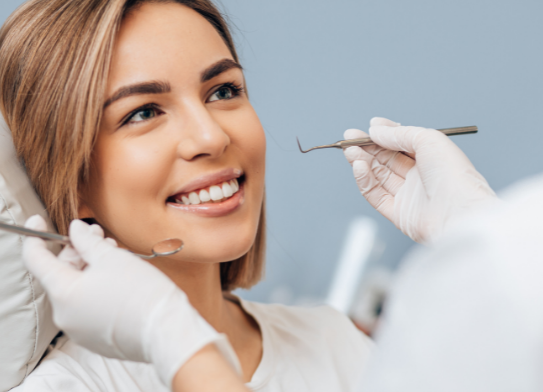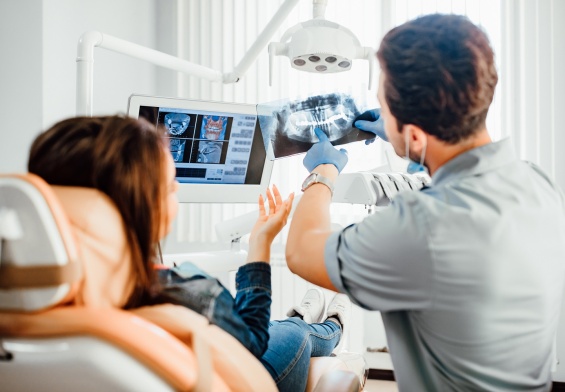Everybody wants to look their best, and bright, white smile is often part of that. Cosmetic dentists in NJ are performing teeth whitening treatments day in and day out. Of course, that proliferation leads to a huge game of telephone that creates tons of opportunities for myths and misinformation.
Social media, well-meaning friends, and outdated dental blogs spread advice that sounds helpful but lacks scientific backing. It’s easy to believe them, but if you do, you might waste your money on disappointing results.
Don’t worry, though. Professional guidance from a cosmetic dentist in NJ can bust these myths and shed some light on how teeth whitening really works. If you’re curious about the process itself, here’s what to expect at your first teeth whitening appointment in NJ.
Let’s take a look at five persistent myths about teeth whitening. Using scientific research and real clinical experience, we’ll reveal what does and doesn’t happen when you whiten your teeth.
Myth 1 – You Must Follow a Strict “White Diet” After Whitening
Certain foods and drinks like coffee, tea, red wine, and more can stain your teeth. If you’re wondering specifically what wine does to teeth, it’s not just about color—it can affect enamel over time.
So, a lot of people think they have to avoid them like the plague after a whitening treatment. Freshly whitened teeth are vulnerable to staining, so it could help to avoid these foods. But, it’s not an absolute necessity like the myth suggests.,
The systematic review “Is a White Diet Necessary for Tooth Bleaching Procedures?” examined this belief directly. Researchers analyzed 17 studies, including five clinical trials, comparing patients who avoided staining foods with those who continued their normal diets.
Measurements taken at one, two, and three weeks after treatment—and again at one month—showed no significant difference in whitening results between the two groups.
In fact, one trial found that patients who drank coffee and wine during their whitening treatment achieved the same improvement as those who didn’t. Similarly, cosmetic dentists in NJ observe that patients who resume normal eating habits, combined with proper oral care, often maintain their results just as effectively.
Don’t think these colorful foods have no impact; that’s another myth for another time. You might also wonder are stained teeth unhealthy teeth? That’s a different question with its own science. Ingesting these foods daily can add surface stains over time, especially if your oral hygiene isn’t the best. Use simple strategies instead of strict dietary restrictions.
For instance, rinsing with water after drinking coffee or tea reduces staining risk without forcing you to give up your favorites. Let’s say you drink two cups of coffee every morning. If you’re brushing your teeth after breakfast and using whitening toothpaste, there’s no harm in that. You’re doing your part to keep your smile bright for months.
Focus on consistent cleaning habits and occasional touch-ups instead of placing these limitations on yourself. This approach helps you maintain the whitening results you worked hard to achieve.
Myth 2 – Whitening Permanently Damages Your Enamel
Fear often surrounds teeth whitening, with many people believing it wears down enamel or causes lasting harm. This belief grew out of cases where treatments weren’t done properly or with professional supervision.
Whitening is incredibly safe when it’s done correctly by a cosmetic dentist in NJ. Peroxide gels may cause temporary surface changes, but these effects are reversible. Your saliva naturally works to remineralize teeth, and certain products can speed up this process.
The review “Tooth Whitening with Hydroxyapatite: A Systematic Review” explored how this mineral supports enamel after whitening. Hydroxyapatite is the same mineral that forms natural tooth enamel. Lab and clinical studies showed that hydroxyapatite toothpaste fills microscopic defects, smooths surfaces, and enhances brightness without causing abrasive wear.
Patients who experience mild sensitivity after whitening often find relief when using hydroxyapatite toothpaste. Their sensitivity goes away, while their teeth feel smoother and look brighter.
The American Dental Association confirms that peroxide whitening is safe when applied in regulated concentrations by trained professionals. The problems that arise come from people using unregulated products purchased online or applying treatments too frequently.
Don’t use any old unknown kit you find online. You could develop gum problems on top of subpar whitening results. But if that does happen, supervised in-office treatment and adding enamel-repairing toothpaste can restore your comfort and appearance.
Choosing a cosmetic dentist in NJ ensures your enamel stays protected while you achieve your desired shade. Professional oversight makes all the difference in both safety and results.
Myth 3 – Over-the-Counter Whitening Works Just as Well as Professional Whitening
People want to believe that over-the-counter, store bought whitening products can match the quality of a professional treatment. That would be nice, but it’s not always the case. These store-bought products do work, just not as well as professional treatments. Several factors explain this difference, including peroxide concentration, application methods, and professional oversight.
The “Is a White Diet Necessary for Tooth Bleaching Procedures?” review compared professional in-office whitening to at-home and store-bought alternatives. Dentists can use higher concentrations of hydrogen peroxide or carbamide peroxide, often combined with light activation, to achieve noticeable results in just one to three sessions.
In contrast, store-bought strips and trays contain lower concentrations. They’re marketed to the public instead of trained medical professionals. Results can take weeks to appear and tend to be inconsistent. The mass-marketed trays don’t fit every mouth perfectly. This can create uneven coloring or leave certain areas untreated.
Many patients start with over-the-counter products, then progress into professional whitening for more dramatic, even results. You might use strips for a month or two, but notice patchiness near the gumline. A single in-office session with custom trays can evenly brighten your smile across all visible teeth.
Professional whitening also allows for immediate sensitivity management. If discomfort occurs, adjustments can be made on the spot. Additionally, professional results tend to last longer, especially when followed by a dentist-approved home maintenance routine.
A cosmetic dentist in NJ can offer the best of both worlds. They might start with high-quality in-office treatment, then provide custom trays for occasional at-home touch-ups. This ensures a bright, even smile without the guesswork and trial-and-error of store-bought products.
Myth 4 – Once You Whiten Your Teeth, the Results Last Forever
This is another one of those things that’s too good to be true, so people want to believe it. The fact of the matter is that whitening results aren’t permanent. They can last a long time, but your teeth are constantly exposed to staining pigments.
Research from “Is a White Diet Necessary for Tooth Bleaching Procedures?” found that some color relapse can occur within six to twelve months. This happens even with excellent home care because aging naturally changes how enamel and dentin reflect light.
So, keeping your smile bright requires keeping up with the maintenance. Using whitening toothpaste or products containing hydroxyapatite, as described in “Tooth Whitening with Hydroxyapatite: A Systematic Review,” helps resist new stains. It’s worth knowing the pros and cons of tooth whitening toothpaste before you choose one. Hydroxyapatite works by smoothing tooth surfaces, making it harder for pigments to attach.
In practice, the best long-term results come from scheduled touch-ups once or twice yearly. Try seeing your NJ cosmetic dentist every spring, for example, for a quick in-office session. Supplement that with custom trays at home for minor boosts.
Regular dental cleanings also play a vital role. Removing plaque and tartar keeps enamel clear and reflective, keeping your teeth brighter for longer. Your dentist can determine whether you need full professional whitening again or just a simple touch-up.
By partnering with a cosmetic dentist in NJ, you can create a maintenance schedule that fits your lifestyle. While whitening provides a significant boost rather than a permanent change, proper planning keeps your teeth looking their best.
Myth 5 – Only Peroxide-Based Products Can Whiten Teeth
While peroxide is the most common whitening ingredient, it’s not your only effective option. Hydroxyapatite is a promising non-peroxide alternative that has shown the ability to whiten teeth while simultaneously strengthening enamel.
The review “Tooth Whitening with Hydroxyapatite: A Systematic Review” documented measurable whitening in both laboratory and clinical studies. Hydroxyapatite particles adhere to enamel, mask yellowish dentin underneath, and fill small surface defects to create a smoother, brighter appearance.
This alternative works particularly well for patients with sensitivity issues or those looking to maintain whitening between peroxide treatments. If you can’t tolerate peroxide because it irritates your gums, switch to hydroxyapatite toothpaste.
Many laboratory studies found hydroxyapatite’s whitening effects comparable to certain peroxide treatments, but with significantly less risk of irritation. Clinical studies confirmed visible improvements after several weeks of regular use.
Some patients benefit most from combining both approaches. A cosmetic dentist in NJ might recommend starting with peroxide for quick initial results, then transitioning to hydroxyapatite for ongoing maintenance. This strategy balances effectiveness, comfort, and long-term enamel health.
Hydroxyapatite is a promising non-peroxide alternative that has shown the ability to whiten teeth while simultaneously strengthening enamel. If you’re interested in other options, check out these top 10 ways to naturally whiten teeth.
Take the Next Step Toward a Brighter Smile
Teeth whitening myths create unnecessary confusion and may prevent you from making informed decisions about your oral health. Current research demonstrates that strict white diets aren’t necessary, supervised whitening doesn’t permanently damage enamel, and professional treatments deliver faster, more consistent results than store-bought alternatives.
Furthermore, understanding that results need maintenance—and that non-peroxide options exist—helps set realistic expectations for your whitening journey.
Working with a cosmetic dentist in NJ allows you to select whitening methods tailored to your specific needs while maintaining results safely over time. Whether you prefer a single in-office treatment or an ongoing maintenance plan, evidence-based care keeps your smile both bright and healthy.
Resources
Epple M, Meyer F, Enax J. A Critical Review of Modern Concepts for Teeth Whitening. Dent J (Basel). 2019;7(3):79. Published 2019 Aug 1. doi:10.3390/dj7030079
Hardan L, Bourgi R, Flores-Ledesma A, et al. Is a White Diet Necessary for Tooth Bleaching Procedures? A Systematic Review and Meta-Analysis. Dent J (Basel). 2024;12(4):118. Published 2024 Apr 22. doi:10.3390/dj12040118
Limeback H, Meyer F, Enax J. Tooth Whitening with Hydroxyapatite: A Systematic Review. Dent J (Basel). 2023;11(2):50. Published 2023 Feb 12. doi:10.3390/dj11020050
Müller-Heupt LK, Wiesmann-Imilowski N, Kaya S, et al. Effectiveness and Safety of Over-the-Counter Tooth-Whitening Agents Compared to Hydrogen Peroxide In Vitro. Int J Mol Sci. 2023;24(3):1956. Published 2023 Jan 19. doi:10.3390/ijms24031956




